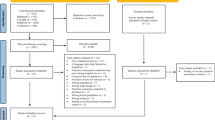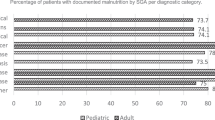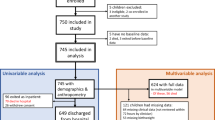Abstract
Background/Objectives
While malnutrition is prevalent in hospitals, little is known about patients who first become malnourished during the hospital stay. This study aimed to determine the incidence and describe the characteristics of patients who developed hospital-acquired malnutrition (HAM) across five Australian public hospitals.
Subjects/Methods
A retrospective clinical audit of hospital data was conducted. Adult patients (aged ≥ 18 years) with a length of stay (LOS) > 14 days in a Metro South Health hospital between July 2015 and January 2019 were eligible. Demographic and clinical data were sourced from hospital data and medical records. Dietitians reviewed the medical records of patients clinically coded with malnutrition to determine HAM incidence. Univariate and logistic regression analyses were used to determine patient descriptors associated with HAM, compared with those not malnourished or those malnourished on admission.
Results
A total of 17,717 patients were eligible (45% F, 63 ± 20 years, LOS 24 (15–606) days). HAM incidence in long-stay patients was 1%, with an overall malnutrition prevalence of 18%. Patients with HAM had an ~26 days longer LOS than patients who were malnourished on admission or not malnourished (p < 0.001). Longer LOS; patient inter-hospital transfer from or to another hospital; or experiencing cognitive impairment, pressure injury or a fall while in hospital were associated with HAM (OR 1.006–3.6, p < 0.05).
Conclusions
Incidence of HAM, defined as malnutrition first diagnosed >14 days after admission, was in the low end of the published range. HAM was significantly associated with long LOS, transferring between hospitals and developing a cognitive impairment, pressure injury or fall during admission.
This is a preview of subscription content, access via your institution
Access options
Subscribe to this journal
Receive 12 print issues and online access
$259.00 per year
only $21.58 per issue
Buy this article
- Purchase on Springer Link
- Instant access to full article PDF
Prices may be subject to local taxes which are calculated during checkout

Similar content being viewed by others
References
Banks M, Bauer J, Graves N, Ash S. Malnutrition and pressure ulcer risk in adults in Australian health care facilities. Nutrition. 2010;26:896–901.
Correia M, Hegazi R, Higashiguchi T, Michel J-P, Reddy B, Tappenden K, et al. Evidence-based recommendations for addressing malnutrition in health care: an updated strategy from the feed M.E. Global Study Group. J Am Med Dir Assoc. 2014;15:544–50.
Lim SL, Ong KCB, Chan YH, Loke WC, Ferguson M, Daniels L. Malnutrition and its impact on cost of hospitalization, length of stay, readmission and 3-year mortality. Clin Nutr. 2011;31:345–50.
Tappenden K, Quatrara B, Parkhurst M, Malone A, Fanjiang G, Ziegler T. Critical role of nutrition in improving quality of care: an interdisciplinary call to action to address adult hospital malnutrition. J Acad Nutr. Dietetics. 2013;113:1219–37.
Agarwal E, Ferguson M, Banks M, Batterham M, Bauer J, Capra S, et al. Malnutrition and poor food intake are associated with prolonged hospital stay, frequent readmissions, and greater in-hospital mortality: Results from the Nutrition Care Day Survey 2010. Clin Nutr. 2012;32:737–45.
Charlton K, Nichols C, Bowden S, Milosavljevic M, Lambert K, Barone L, et al. Poor nutritional status of older subacute patients predicts clinical outcomes and mortality at 18 months of follow-up. Eur J Clin Nutr. 2012;66:1224–8.
Allard JP, Keller H, Jeejeebhoy KN, Laporte M, Duerksen DR, Gramlich L, et al. Decline in nutritional status is associated with prolonged length of stay in hospitalized patients admitted for 7 days or more: a prospective cohort study. Clin Nutr. 2016;35:144–52.
The Australian Commission on Safety and Quality in Health Care. Hospital acquired complications information kit Sydney: ACSQHC; 2018. Accessed 9 July 2019. https://www.safetyandquality.gov.au/wpcontent/uploads/2018/06/SAQ7730_HAC_InfomationKit_V2.pdf.
Independent Hospital Pricing Authority. Pricing and funding for safety and quality—risk adjustment model for hospital acquired complications Sydney; 2018 Accessed 9 July 2019. https://www.ihpa.gov.au/publications.
Cheng J, Witney-Cochrane K, Cunich M, Ferrie S, Carey S. Defining and quantifying preventable and non-preventable hospital-acquired malnutrition-a cohort study. Nutr Dietetics. 2019;76:620–7.
Detsky A, McLaughlin, Baker J, Johnston N, Whittaker S, Mendelson R, et al. What is subjective global assessment of nutritional status? J Parenter Enter Nutr. 1987;11:8–13.
Alvarez-Hernandez J, Vila MP, Leon-Sanz M, de Lorenzo AG, Celaya-Perez S, Garcia-Lorda P, et al. Prevalence and costs of malnutrition in hospitalized patients; the PREDyCES (R) Study. Nutricion Hospitalaria 2012;27:1049–59.
Ballesteros-Pomar MD, Calleja-Fernández A, González-Valdés M, Pintor-de la Maza B, Villar Taibo R, Vidal-Casariego A, et al. Clinical and financial implications of disease-related malnutrition in a department of Internal Medicine: prospective cohort study. Rev Clin Espanola. 2016;216:468.
Braunschweig C, Gomez S, Sheean PM. Impact of declines in nutritional status on outcomes in adult patients hospitalized for more than 7 days. J Am Dietetic Assoc. 2000;100:1316–22.
McWhirter JP, Pennington CR. Incidence and recognition of malnutrition in hospital. BMJ 1994;308:945–8.
Mosselman MJ, Kruitwagen CLJJ, Schuurmans MJ, Hafsteinsdóttir TB. Malnutrition and risk of malnutrition in patients with stroke: prevalence during hospital stay. J Neurosci Nurs. 2013;45:194–204.
Patel MD, Martin FC. Why don’t elderly hospital inpatients eat adequately? J Nutr, Health Aging. 2008;12:227–31.
Trombetti A, Cheseaux J, Herrmann FR, Rizzoli R. A critical pathway for the management of elderly inpatients with malnutrition: Effects on serum insulin-like growth factor-I. Eur J Clin Nutr. 2013;67:1175–81.
Whitley A, Skliros E, Graven C, McIntosh R, Lasry C, Newsome C, et al. Changes in nutritional and functional status in longer stay patients admitted to a geriatric evaluation and management unit. J Nutr, Health Aging. 2017;21:686–91.
Zhang J, Zhao X, Wang A, Zhou Y, Yang B, Wei N, et al. Emerging malnutrition during hospitalisation independently predicts poor 3-month outcomes after acute stroke: data from a Chinese cohort. Asia Pac J Clin Nutr. 2015;24:379–86.
Queensland Government. Metro South Health – About Us 2017. Aaccessed 9 July 2019. https://metrosouth.health.qld.gov.au/about-us.
Ferguson M, Capra S, Bauer J, Banks M. Development of a valid and reliable malnutrition screening tool for adult acute hospital patients. Nutrition. 1999;15:458–64.
Independent Hospital Pricing Authority. Admitted acute care 2019. Aaccessed 19 December 2019. https://www.ihpa.gov.au/what-we-do/admitted-acute-care.
Lackoff AS, Hickling DF, Collins PF, Stevenson KJ, Nowicki TA, Bell JJ. The association of malnutrition with falls and harm from falls in hospital inpatients: findings from a 5-year point prevalence study. Clin Nutr. 2018;37:S106–S.
Orsitto G, Fulvio F, Tria D, Turi V, Venezia A, Manca C. Nutritional status in hospitalized elderly patients with mild cognitive impairment. Clin Nutr. 2008;28:100–2.
Neloska L, Damevska K, Nikolchev A, Pavleska L, Petreska-Zovic B, Kostov M. The association between malnutrition and pressure ulcers in elderly in long-term care facility. Macedonian J Med Sci. 2016;4:423–7.
Cornell Statistical Consulting Unit. Adjusted standardized residuals for interpreting contingency tables 2018. Accessed 9 July 2019. https://www.cscu.cornell.edu/news/statnews/stnews95.pdf.
Kellett J, Kyle G, Itsiopoulos C, Naunton M, Luff N. Malnutrition: the importance of identification, documentation, and coding in the acute care setting. J Nutr Metab. 2016;2016:9026098–6.
Lazarus C, Hamlyn J. Prevalence and documentation of malnutrition in hospitals: a case study in a large private hospital setting. Nutr Dietetics. 2005;62:41–7.
Gout B, Barker L, Crowe T. Malnutrition identification, diagnosis and dietetic referrals: Are we doing a good enough job? Nutr Dietetics. 2009;66:206–11.
Bauer JD, Hiscocks K, Fichera R, Horsley P, Martineau J, Denmeade S, et al. Nutritional status of long‐term patients in the acute care setting. Intern Med J. 2012;42:1251–4.
Kulshrestha A, Singh J. Inter-hospital and intra-hospital patient transfer: recent concepts. Indian J Anaesth. 2016;60:451–7.
Havens JM, Columbus AB, Seshadri AJ, Olufajo OA, Mogensen KM, Rawn JD, et al. Malnutrition at intensive care unit admission predicts mortality in emergency general surgery patients. J Parenter Enter Nutr. 2018;42:156–63.
Coleman EA. Falling through the cracks: challenges and opportunities for improving transitional care for persons with continuous complex care needs. J Am Geriatrics Soc. 2003;51:549–55.
Magri F, Borza A, del Vecchio S, Chytiris S, Cuzzoni G, Busconi L, et al. Nutritional assessment of demented patients: a descriptive study. Aging Clin Exp Res. 2003;15:148–53.
Mudge AM, Ross LJ, Young AM, Isenring EA, Banks MD. Helping understand nutritional gaps in the elderly (HUNGER): A prospective study of patient factors associated with inadequate nutritional intake in older medical inpatients. Clin Nutr. 2011;30:320–5.
Oliver D, Healey F, Haines T. Preventing falls and fall-related injuries in hospitals. Clin Geriatr Med. 2010;26:645–92.
Acknowledgements
The authors wish to thank the Health Information Management department of Metro South Health for their assistance with the project. The authors acknowledge the contribution from the Metro South Health Biostatistics Service provided by Queensland Facility for Advanced Bioinformatics (QFAB), University of Queensland.
Author information
Authors and Affiliations
Contributions
CJ and MP conceived the study. All authors contributed to the study design. TW, CJ, MP, JH, FN, BH and RS collected the data. TW and MP analysed the data. TW, LR and MP drafted the manuscript. All authors critically reviewed and approved the final draft submitted for publication.
Corresponding author
Ethics declarations
Conflict of interest
The authors declare that they have no conflict of interest.
Additional information
Publisher’s note Springer Nature remains neutral with regard to jurisdictional claims in published maps and institutional affiliations.
Supplementary information
Rights and permissions
About this article
Cite this article
Woodward, T., Josephson, C., Ross, L. et al. A retrospective study of the incidence and characteristics of long-stay adult inpatients with hospital-acquired malnutrition across five Australian public hospitals. Eur J Clin Nutr 74, 1668–1676 (2020). https://doi.org/10.1038/s41430-020-0648-x
Received:
Revised:
Accepted:
Published:
Issue Date:
DOI: https://doi.org/10.1038/s41430-020-0648-x
This article is cited by
-
Incidence and criteria used in the diagnosis of hospital-acquired malnutrition in adults: a systematic review and pooled incidence analysis
European Journal of Clinical Nutrition (2023)



